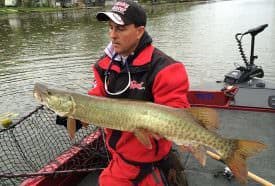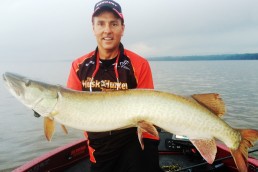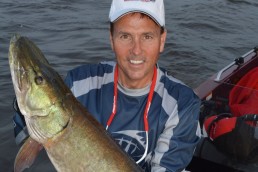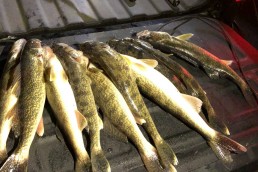Four Factors for Early-season Muskie Success
SHARE THIS POST
There is something magical about that first trip of the year. Visions of multiple fish days race through your head. You have a plan that you are sure will work, and the first strike should happen any second. Unfortunately, even the best made plans don’t always work out. Spring weather can be crazy, even in the reservoirs located in the lower Midwest or South. Rapidly dropping air temperatures associated with cold fronts remind you that winter isn’t entirely finished. Even when it’s unseasonably warm you can usually count on strong winds to make fishing difficult. I remember fishing one day last spring when it was 75 degrees Fahrenheit with sustained winds over 25 mph for the entire day. I felt like I spent the day in a convection oven. Regardless, nothing beats being on the water knowing the muskie season is just beginning.
To be successful in spring you have to be willing to fish multiple areas and utilize several lure techniques. Sometimes you must have the fortitude to stick with a particular spot or pattern knowing that the muskies live there and sometime throughout the day they are going to bite. When fishing in the spring, I always consider the following four factors when selecting where to fish, what lures to use, and when to go fishing: water temperature, spawning progression, smaller lures, and the local weather pattern.
Always try to find the warmest water temperatures and an area that is only two degrees warmer can be significant. Pockets of warmer water occur due to solar heat, water color and even wind. Find them and your odds increase. Take a look at the map and determine which areas may be wind protected and have greater sun exposure, therefore being warmer. If there is some type of warm-water discharge entering the lake, that’s even better. Focus on finding spots where the water is warmest. Although the muskies may not successfully spawn in many southern waters, they still go through the process and their attitudes may reflect it, and generally they are most difficult to catch during the spawning process.
Are you enjoying this post?
You can be among the first to get the latest info on where to go, what to use and how to use it!

Muskies generally spawn when the water temperatures are between 50 and 60 degrees Fahrenheit, and not all of the fish spawn at the same time. It’s important to know if you are dealing with pre-spawn, spawning, or post-spawn muskies. It can impact location and the nature of the muskies. Contact a bait shop, local guide or the regional department of natural resources to find out if the muskies are spawning or what’s happening in relation to this spawning cycle. Further, if you can figure out where the muskies spawn you know the general area you need to concentrate your efforts, along with finding the warmest water.
Smaller lures generally rule in early season. Sure you catch muskies on larger lures in spring, particularly in waters that have Shad as the primary muskie forage. However, smaller lures 7 inches and less are still most productive. So, I’ll focus on bringing an arsenal of smaller baits for both casting and trolling, and limit my selection of large baits to only a few. Unfortunately, as much as we hate to admit it, local weather conditions have almost as much impact on our fishing success as the spots and lures we select. Before leaving for your first spring trip, pay attention to the local weather trends leading into and during your trip. Ideal weather conditions include a warming trend or at least stable conditions. A forecast for colder air temperatures and northerly winds are usually a sign to postpone the trip for another week. Everyone hates to cancel plans, but if you can go a week later, chances are your trip will be much more successful.
There are lots of factors that come into play on any early season trip such as which specific areas to fish and what lures to select for the give cover and weather conditions. However, all of those choices are predicated on the above-mentioned for topics to consider. If you know where the muskies are in relation to the spawning process, then find the warmest water closest to the spawning areas, and attack the area with smaller lures, you significantly increase your odds at having a great early-season trip.
MWO
SHARE THIS POST
Did you enjoy this post?
You can be among the first to get the latest info on where to go, what to use and how to use it!
Jim Saric
Jim Saric is a Legendary Angler in the Freshwater Fishing Hall of Fame, the host and executive producer of The Musky Hunter television series, editor at large of Musky Hunter magazine, a seven-time muskie tournament winner, and a contributing writer for numerous other publications.



